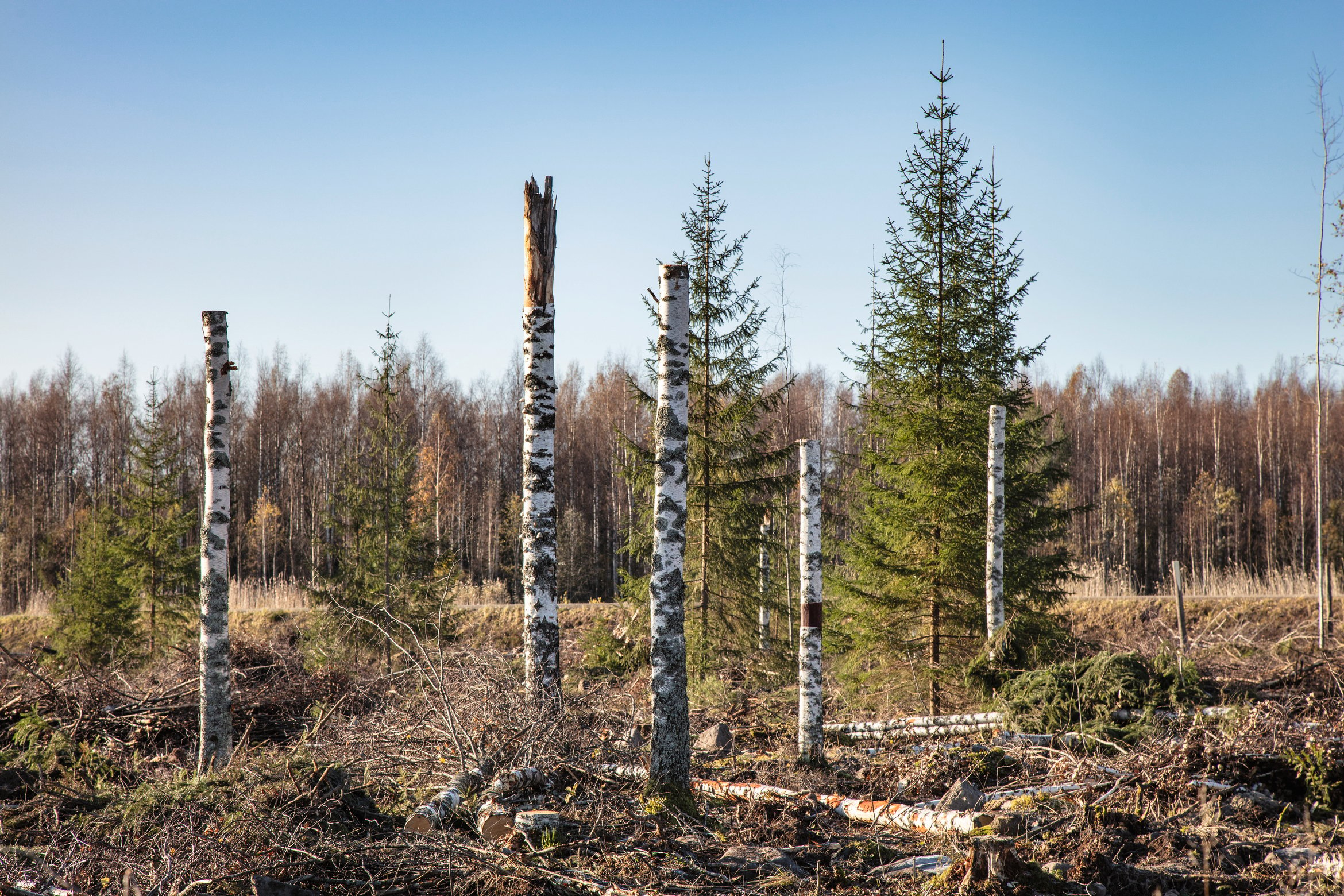Sallow, aspen and alder here and there. Young spruce trees and birch and pine trunks cut at a height of 3–6 metres.
Ville Hirvonen inspects the results of the first final cutting performed in accordance with the Metsä Group Plus management model at his home farm in Rääkkylä in North Karelia. There are now many more high biodiversity stumps and retention trees on the felling site than normal, totalling around 250.
“The first time I saw this, I was struck by the number of high biodiversity stumps, but I got used to it quickly. It looks pretty good,” says Hirvonen, 48.
Forest growing on a former lake bottom reached final cutting age
The landscape looks special in other respects as well.
There is a wide open field, the Oravilahti drying zone, to the east.
Hirvonen calls it Finland’s largest polder, a basin lying lower than the surrounding water surface, typically seen in the Netherlands. A raised road more than ten kilometres long separates us from the Saimaa water surface.
“There was talk about drying up Oravilahti back in the 1930s. The plan was finally carried out in the 1960s. In 1965, the area was pumped dry,” Hirvonen says.
As a result, the lake bottom yielded an area covering nearly a thousand hectares. Most of it is used for agriculture, but the stony parts remained as alluvial areas and were left to grow over as forest.
“The birch stand on our felling site was naturally generated and somewhat uneven in terms of its trees,” says Hirvonen, who has been running his farm and forest estate since 2001.
“Must try something new”
Hirvonen has been following Metsä Group’s services from up close. He was a member of Metsäliitto Cooperative’s Supervisory Board until last spring.
So he already knew the principles of the Metsä Group Plus service, launched last summer, before his first-hand experience.
“Forestry is quite a conservative sector. It can take decades to correct mistakes. I decided to test it out of personal interest. When something new is launched, you have to test it, don’t you?”
Hirvonen admits that a staunch supporter of efficient forest management like him may need some time to get used to the number of high biodiversity stumps and retention trees left in the forest clearly exceeding forest certification requirements.
Metsä Group’s owner-members receive a bonus per hectare for regeneration felling carried out in accordance with the Metsä Group Plus model. The payment compensates the wood trade income that is lost when retention trees are left standing.
Ville Hirvonen is still assessing the economic impacts of the new model and the success of harvesting.
“I’m a little nervous about the birches left standing, and how long they remain upright. At least the storms this autumn didn’t bring down all that many trees.”
Biodiversity actions balance risks
According to Hirvonen, measures promoting forest biodiversity affect forest owners’ wallets in the short term.
But there’s another side to the coin.
“Biodiversity actions don’t yield the best financial result in felling but in the long term, they balance the risks in forestry. We’ve realised this in Finland, as some of our forests are dominated excessively by spruce and exposed to insect, fungal and other damage.
The amount of decaying wood is critical to the biodiversity of forest nature. There is a lot less decaying wood in commercial forests than in natural forests. It is also more one-sided.
For many years, decaying wood has been added by leaving retention trees and high biodiversity stumps on felling stands. However, recent studies indicate that more is needed.
Especially after final cutting, the continued availability of decaying wood is often weak. At least the Rääkkylä felling site brought a change to this.
“Now, I expect the amount of decaying wood developing on this site to be quite large. There will be a continuation of decaying wood, offering better conditions for the species inhabiting it,” says Hirvonen.

More decaying wood quickly from high biodiversity stumps
There are high biodiversity stumps everywhere on Hirvonen’s felling site. Some retention trees have also been left here and there, but most are placed in two large groups.
“The retention trees were placed in the wettest spots, determined by a wet area map,” says Tuomas Kiljunen, Metsä Group’s forest specialist, who planned the site.
He says the site had no decaying wood or individual old trees at the time of felling. The conditions are now better for both.
"High biodiversity stumps are a quick way to add decaying wood. Deciduous trees begin decaying immediately, and in a few years, this site will also have decaying wood. Decaying wood is home to predator insects that are useful for forest owners because they keep harmful bark beetle populations like the European spruce bark beetle in check,” Kiljunen says.
This text is an abridged version of an article originally published in issue 4/2023 of Metsä Group’s Viesti magazine.
Text Heikki Hamunen
Photos Harri Mäenpää
